One of the great things about living in the San Francisco Bay and Delta Region is the many saltwater options you have. You can go fishing for salmon outside the Golden Gate, fish live bait for halibut and striped bass inside the bay, target rockfish w and lingcod, or go for big rockfish and lingcod at the Farallon Islands.
The 24 members of the California Striped Bass Association (CSBA), West Delta Chapter, and their friends made a very successful charter to the Farallon Islands aboard Berkeley’s California Dawn, skippered by Captain James Smith, on August 8.
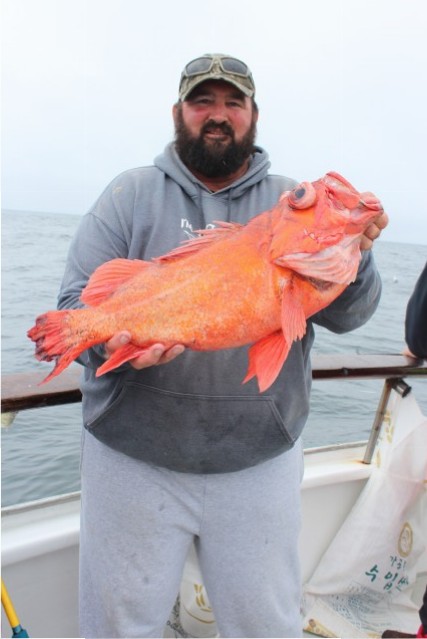
The highlight of the trip in 2015 was a wide-open striped bass bite we experienced in San Francisco Bay off the Rockpile. Many anglers released their fish back into the bay.
This year, fishing at the legendary island chain 30 miles west of San Francisco, has been superb when seas allow charter boats to get there.
After the 2-1/2 hour ride on little bouncy but otherwise calm seas, we arrived at the Farallon Islands. The water near the islands was calmer than it was closer to the Golden Gate.
“I recommend that you target the rockfish first with shrimp flies. Then after you are getting close to your limit, that’s the time to put the trap rig on,” said Smith.
Most of the anglers, including myself, followed Smith’s advice. I soon began hooking up one rockfish after other, along with other anglers. This was the first trip to the Island in many years that I was able to take advantage of fishing the 180 to 240 feet depths after the Rockcod Conservation Zone, an effort by the Pacific Fishery Management Council to rebuild rockfish populations, went into place over 15 years ago.
The rockfish action was great throughout the trip, but the top lingcod fishing was in the last two hours of the day when anglers put one fish after another into the boat.
Everybody went home from the trip with their10 fish rockfish limits and two fish lingcod limits. Noel O’Brien, President of the CSBA, Isleton Chapter, won the jackpot by boating an 18 lb. lingcod. Dave Newton landed the biggest red rockfish, a vermilion over 10 pounds.
Anglers landed a colorful array of bottomfish, including olive, copper, vermilion, bocaccio, starry, canary and flag rockfish. The anglers targeted the rockfish with shrimp flies, jigs, swimbaits, and other lures.
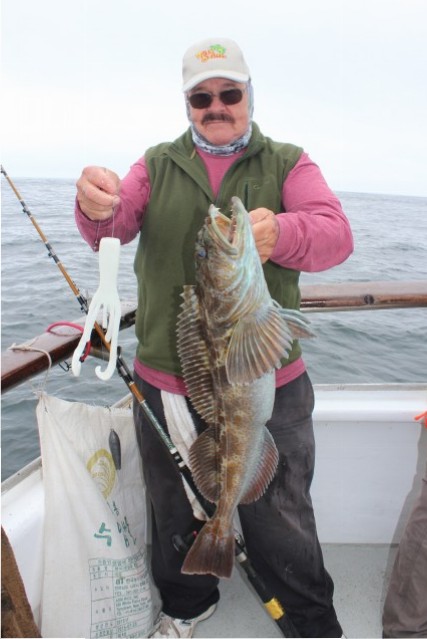
The fishermen caught lingcod on frozen mackerel and sardines and live bait fished on trap rigs. However, fishing was best on jigs and bars thrown from the bow. Cal Kellogg, Fish Sniffer editor, experienced top-notch lingcod action while throwing 12 oz. Ahi jigs.
“The key to success with the bars is to cast it out there and then hop and swim the jig on the bottom,” advised Kellogg. “It’s really a finesse technique, since it necessary to keep your thumb and forefinger on the line on the line at fall times to feel exactly what’s going on.”
“It was great to share a day of fishing fun with our members and friends,” commented Roger Mammon, chapter president and secretary of Restore the Delta. “Everybody went home with plenty of fish for their families.”
The purpose of the CSBA, founded by Jay Sorensen of Stockton in 1974, is “the preservation, protection and enhancement of striped bass.”
“We are the only organizing focusing on restoring the fish of the Delta,” Mammon pointed out. “The problem with the Sacramento-San Joaquin River Delta now is that it is not allowed to function as a Delta by the state and federal government water agencies. This facilitates the grow of non native plants, such as egeria.”
CSBA members are among the stalwart defenders of the Delta and its fisheries – and the most vocal opponents of the Delta Tunnels. Over the past couple of decades, I’ve been with CSBA members at everything from protests against the Delta Tunnels, to legislative hearings on bills designed by agribusiness to exterminate striped bass, to Fish and Game Commission meetings addressing striped bass regulations, the Marine Life Protection Act (MLPA) Initiative and other issues.
The CSBA also strongly supports efforts to introduce children and families to fishing. The CSBA’s late member, Uril “Compy” Compomizzo started the “Hooked on Fishing, Not Drugs” fishing program and kids fishing derby. The West Delta Chapter continues that tradition and conducts a Kid’s Free Fishing Derby every year at Contra Loma Reservoir or the San Joaquin River in Antioch.
The derby this year will be on October 14 from 8 am to 11 am at the Antioch Fishing Pier, located at the north end of L Street, by the old Humphrey’s Restaurant. For more information, go to: http://www.csbawestdeltachapter.org/ or their Facebook page.
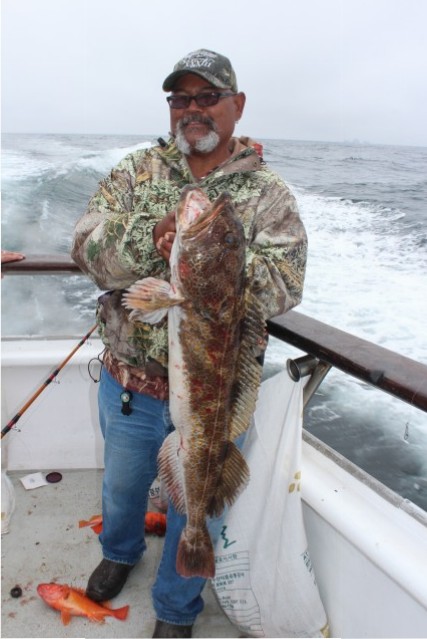
The Farallon Islands, or Farallones (from the Spanish Farallon meaning “pillar” or “sea cliff”), are a group of islands and sea stacks in the Gulf of the Farallones, off the coast of San Francisco, according to Wikipedia. The islands and the gulf of the Farallones that it has created are one of the richest ecosystems in the world, sustaining an array of birds, fish and invertebrates, ranging from giant Great White Sharks to tiny kill and other forage that provide forage for a variety of fish species.
Anglers and other boaters often refer to the Farallones as the “Devil’s Teeth Islands,” in reference to the many treacherous underwater shoals in their vicinity. The islands lie 30 miles outside the Golden Gate and 20 miles south of Point Reyes, and are visible from the mainland on clear days. The islands are officially part of the City and County of San Francisco.
The only inhabited portion of the islands is on Southeast Farallon Island (SEFI), where researchers from Point Blue Conservation Science and the U.S. Fish and Wildlife Service stayThe islands are closed to the public
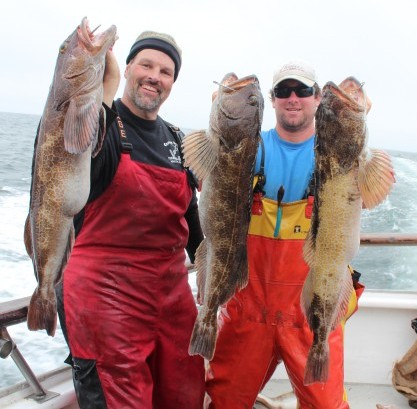
The Farallon National Wildlife Refuge is one of 63 National Wildlife Refuges that have congressionally designated wilderness status. In 1974 the Farallon Wilderness was established (Public Law 93-550) and includes all islands except the Southeast Island for a total of 141 acres.
The islands were long known by the name “Islands of the Dead” to the Ohlone Indians who lived in the Bay Area prior to the arrival of Europeans. They are not thought to have traveled to them. This was either for practical reasons, since the voyage and landing would be difficult and dangerous, or because of Indians’ belief the islands were the abode of the spirits of the dead, noted Wikipedia.
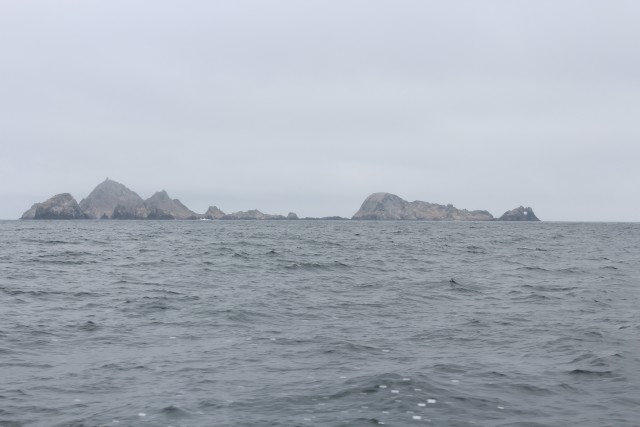
Marin Coast/Farallon Islands Facts
Rockfish Regulations: The recreational fishery for rockfish (Sebastes sp.) is open to divers and shore-based anglers year-round. This fishery is open to boat-based anglers from April 15, 2017 through December 31, 2017. These species may only be taken or possessed in waters less than 240 feet (40 fathoms) deep. The daily bag and possession limit is 10 fish in combination of all species within the RCG Complex (includes all species of Rockfish, Cabezon and Greenlings) per person, with a sub-limit on black rockfish (3 per person) and canary rockfish (1 per person), also included in the 10 fish RCG Complex aggregate limit. Yelloweye rockfish bronzespotted rockfish, and cowcod may not be retained (bag limit: zero).
Lingcod Regulations: The recreational fishery for lingcod (Ophiodon elongatus) is open to divers and shore-based anglers year-round. This fishery is open to boat-based anglers from April 15, 2017 through December 31, 2017. Lingcod may only be taken or possessed in waters less than 240 ft (40 fm) deep. The daily bag and possession limit is 2 fish, with a minimum size limit of 22 inches total length.
Other Species: Fishing for halibut, striped bass and leopard sharks is open year round in San Francisco Bay and outside of the Golden Gate. The bag limit for striped bass is two fish 18 inches or over; halibut, three fish over 22 inches; and leopard sharks, 3 fish over 36 inches. There are seasonal closures for salmon, sturgeon and soupfin sharks in San Francisco Bay.
Charter boats: Sportfishing boats from throughout the Bay Area target rockfish, lingcod, halibut, striped bass and king salmon on San Francisco Bay and outside of the Golden Gate during their respective seasons. Contact Captain James Smith of the California Dawn, (510) 417-5557. Other boats booking trips out of the Berkeley Marina include the; New Easy Rider, (707) 422-2050; Captain Hook, (510) 322-0493; Happy Hooker, (510) 773-4158, Hook’d Up Sportfishing, (707) 655-6736; Goldeneye 2000, (510) 610-0888, or Bay Charter Boats, 510-850-2285 or cell 510-672-6913, For more information, call the Berkeley Marina Sportfishing Center, (510) 849-3333.The New Huck Finn, Sundance, Superfish, C-Gull II, New Seeker, New Salmon Queen, Sea Wolf and Wet Spot depart from the Emeryville Sportfishing Center, (510) 654-6040.The Bass Tub, (415) 456-9055, and Silver Fox Sportfishing, (415) 367-5600, depart from Fisherman’s Wharf in San Francisco, while the Predator, (707) 342-8481, is berthed at the Vallejo Marina.
